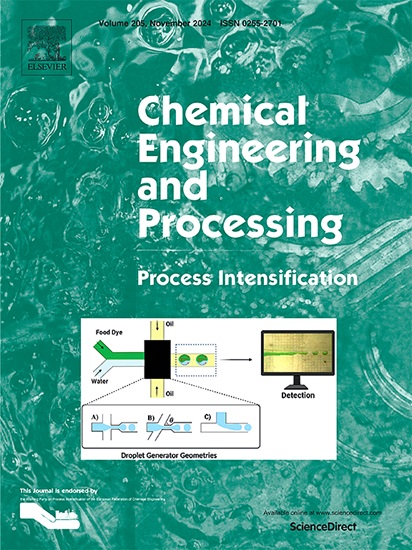Removal of nitric oxide from gas streams by droplet triggered gas discharge
IF 3.8
3区 工程技术
Q3 ENERGY & FUELS
Chemical Engineering and Processing - Process Intensification
Pub Date : 2025-03-04
DOI:10.1016/j.cep.2025.110260
引用次数: 0
Abstract
The study investigated nitrogen oxide (NO) removal using gas discharge plasma technology, by an enhanced plate-plate corona discharge reactor. This reactor was an improvement over the traditional wire-plate reactor, featuring an added water dripping device above the reactor. The downward dripping water facilitated the discharge between the electrode plates, while simultaneously absorbing the nitrogen dioxide (NO2) produced during the reaction and converting it into nitric acid (HNO3). The effects of water droplets and different process parameters (voltage, residence time, NO inlet concentration, and oxygen concentration) on NO removal were investigated. The reaction mechanism and the optimal energy efficiency were further discussed. The results showed that the removal efficiency of NO reached 61.5 %, with an energy efficiency of 0.204 mg kJ−1, under the optimal conditions of a 14 kV direct current voltage, a flue gas flow rate of 1.5 L·min−1, an initial NO concentration of 350 mg·m−3, an oxygen flow rate of 40 mL min−1, and a droplet dropping rate of 10 mL min−1. Moderate water droplets can promote discharge reactions and NO conversion to HNO3, but excessive droplets can reduce discharge effectiveness and NO removal efficiency, and lead to voltage breakdown and electric leakage. Moreover, the generated HNO3 in water solution can be recycled and reused, suggesting significant industrial application potential.

通过液滴触发气体放电从气流中去除一氧化氮
采用增强型板-板电晕放电反应器,研究了气体放电等离子体技术对氮氧化物(NO)的去除效果。该反应器是对传统线板反应器的改进,在反应器上方增加了滴水装置。向下滴下的水促进了极板之间的放电,同时吸收了反应过程中产生的二氧化氮(NO2)并将其转化为硝酸(HNO3)。考察了不同工艺参数(电压、停留时间、NO进口浓度、氧浓度)和水滴对NO去除率的影响。进一步讨论了反应机理和最佳能量效率。结果表明,在直流电压14 kV、烟气流量1.5 L·min−1、初始NO浓度350 mg·m−3、氧气流量40 mL min−1、液滴滴速10 mL min−1的最佳条件下,NO的去除率可达61.5%,能量效率为0.204 mg kJ−1。适量的水滴可以促进放电反应,促进NO向HNO3的转化,但水滴过多会降低放电效果和NO去除效率,导致电压击穿和漏电。此外,水溶液中生成的HNO3可以回收再利用,具有很大的工业应用潜力。
本文章由计算机程序翻译,如有差异,请以英文原文为准。
求助全文
约1分钟内获得全文
求助全文
来源期刊
CiteScore
7.80
自引率
9.30%
发文量
408
审稿时长
49 days
期刊介绍:
Chemical Engineering and Processing: Process Intensification is intended for practicing researchers in industry and academia, working in the field of Process Engineering and related to the subject of Process Intensification.Articles published in the Journal demonstrate how novel discoveries, developments and theories in the field of Process Engineering and in particular Process Intensification may be used for analysis and design of innovative equipment and processing methods with substantially improved sustainability, efficiency and environmental performance.

 求助内容:
求助内容: 应助结果提醒方式:
应助结果提醒方式:


